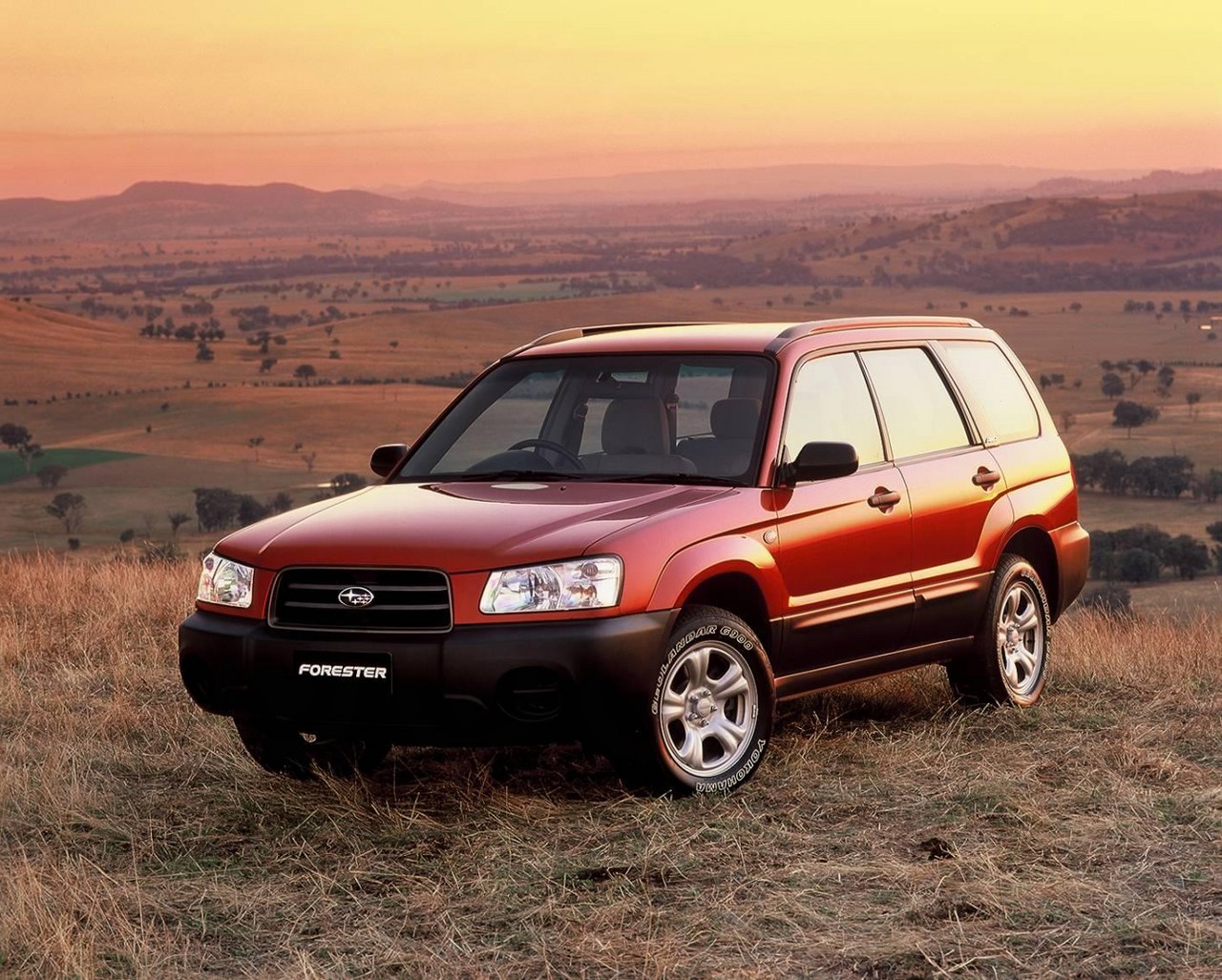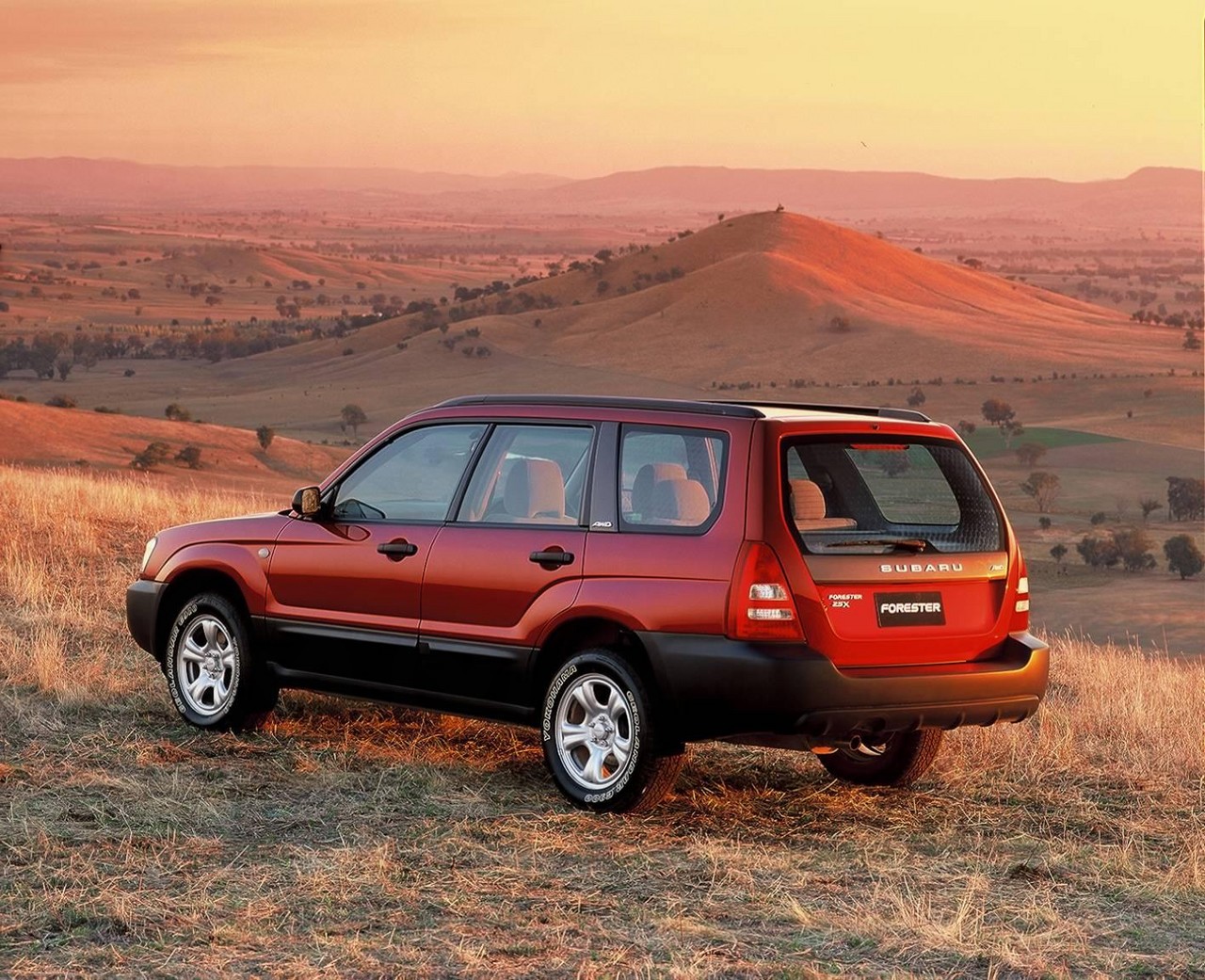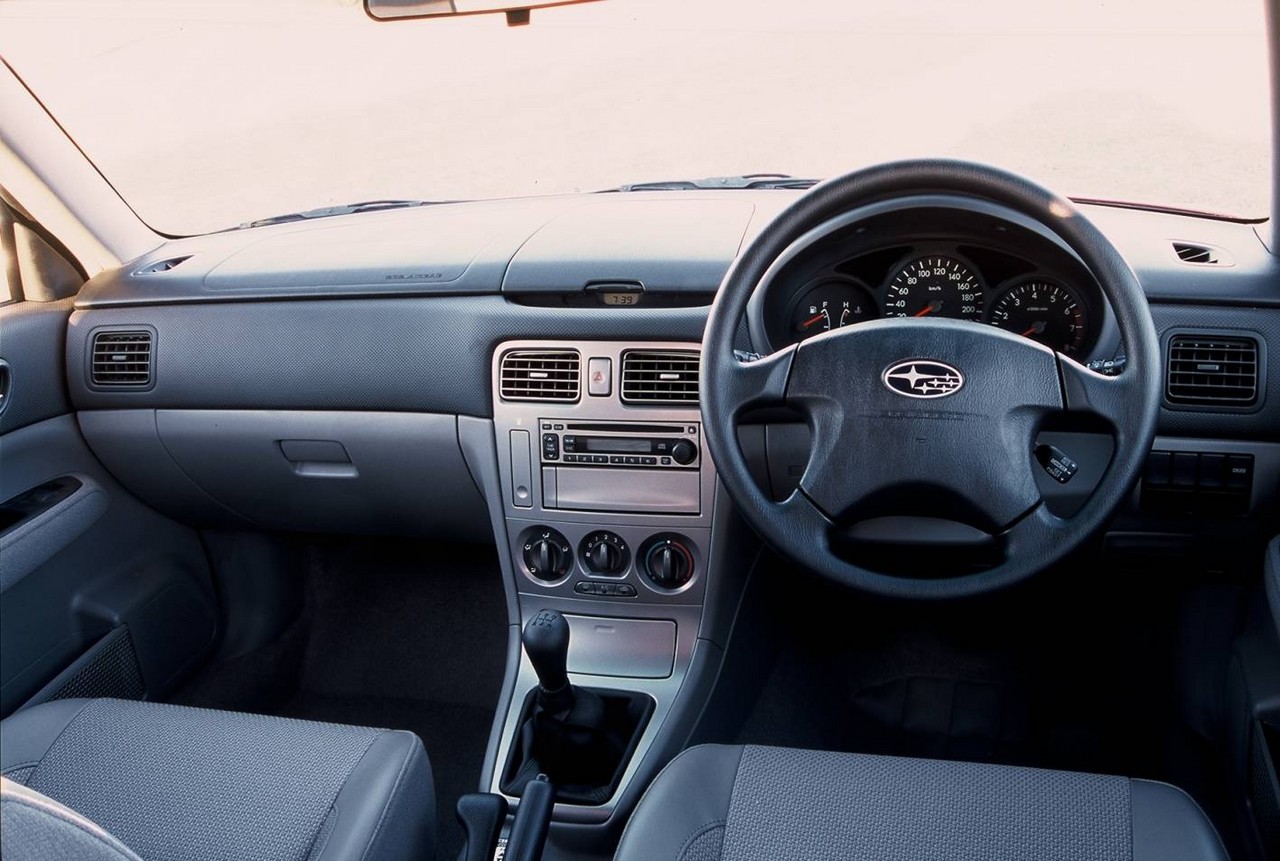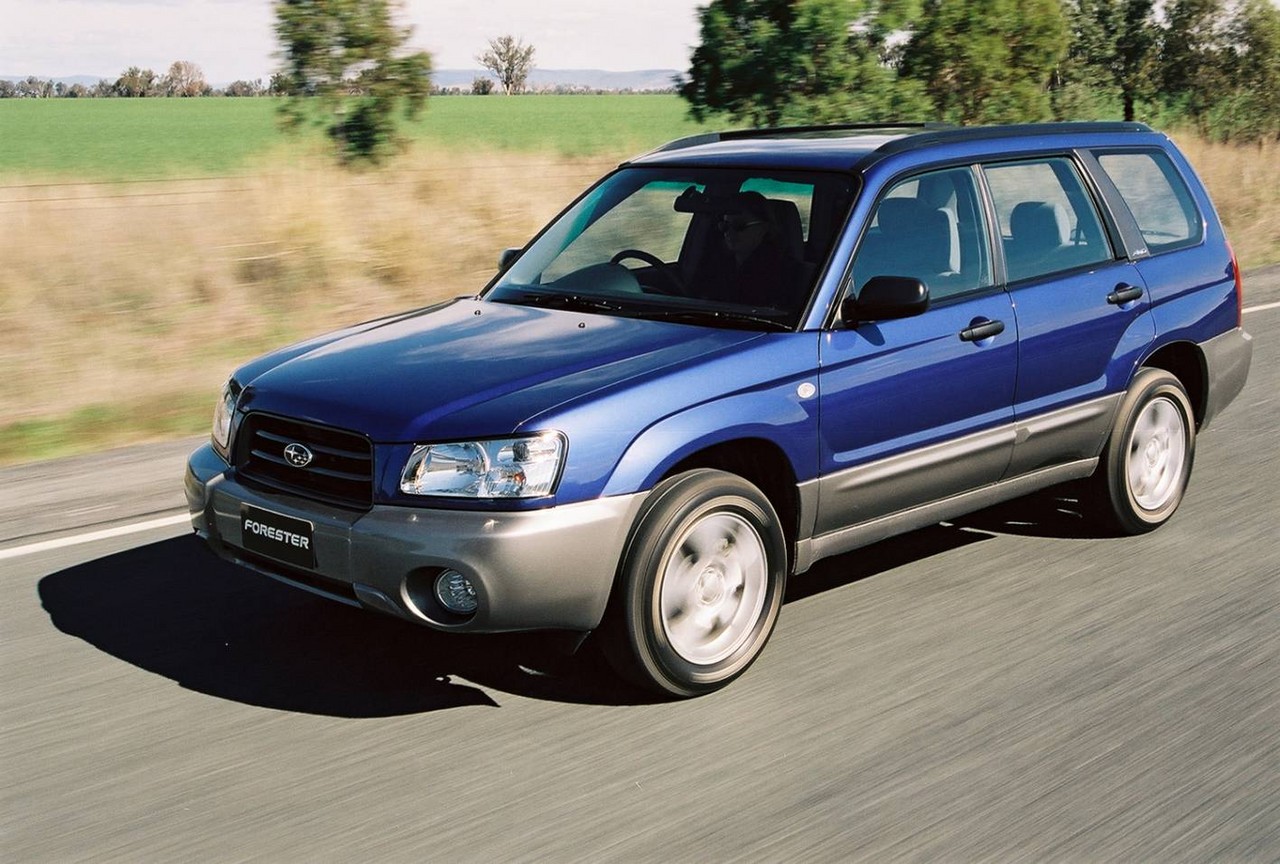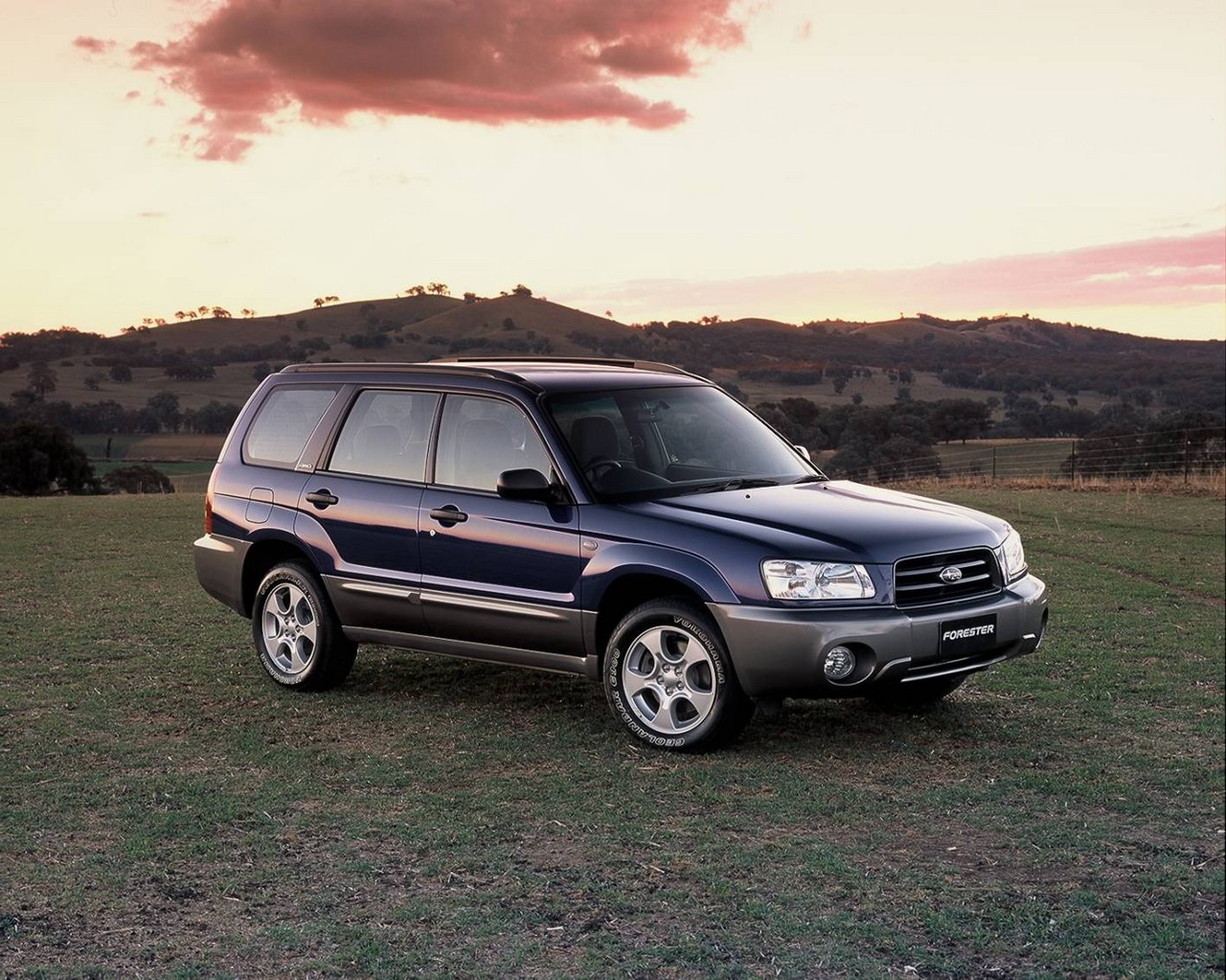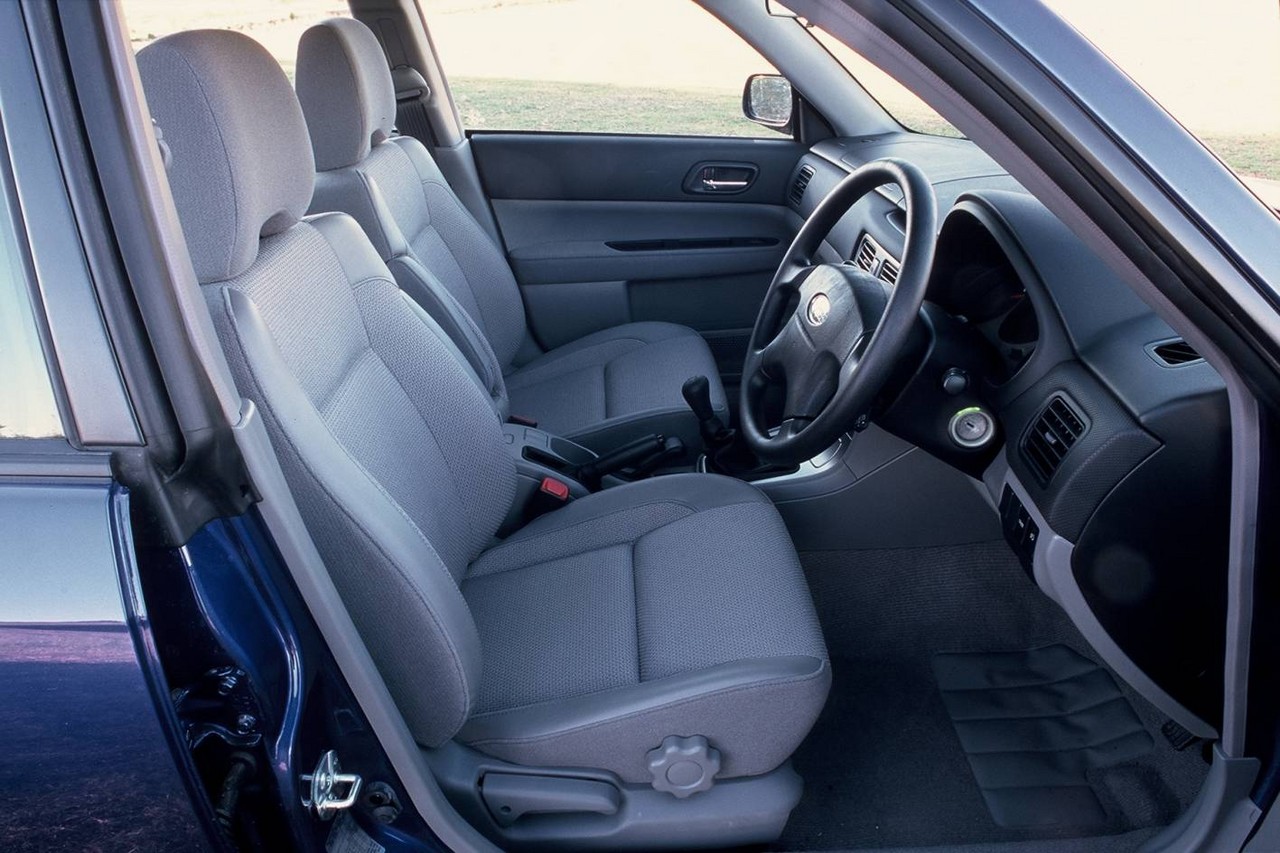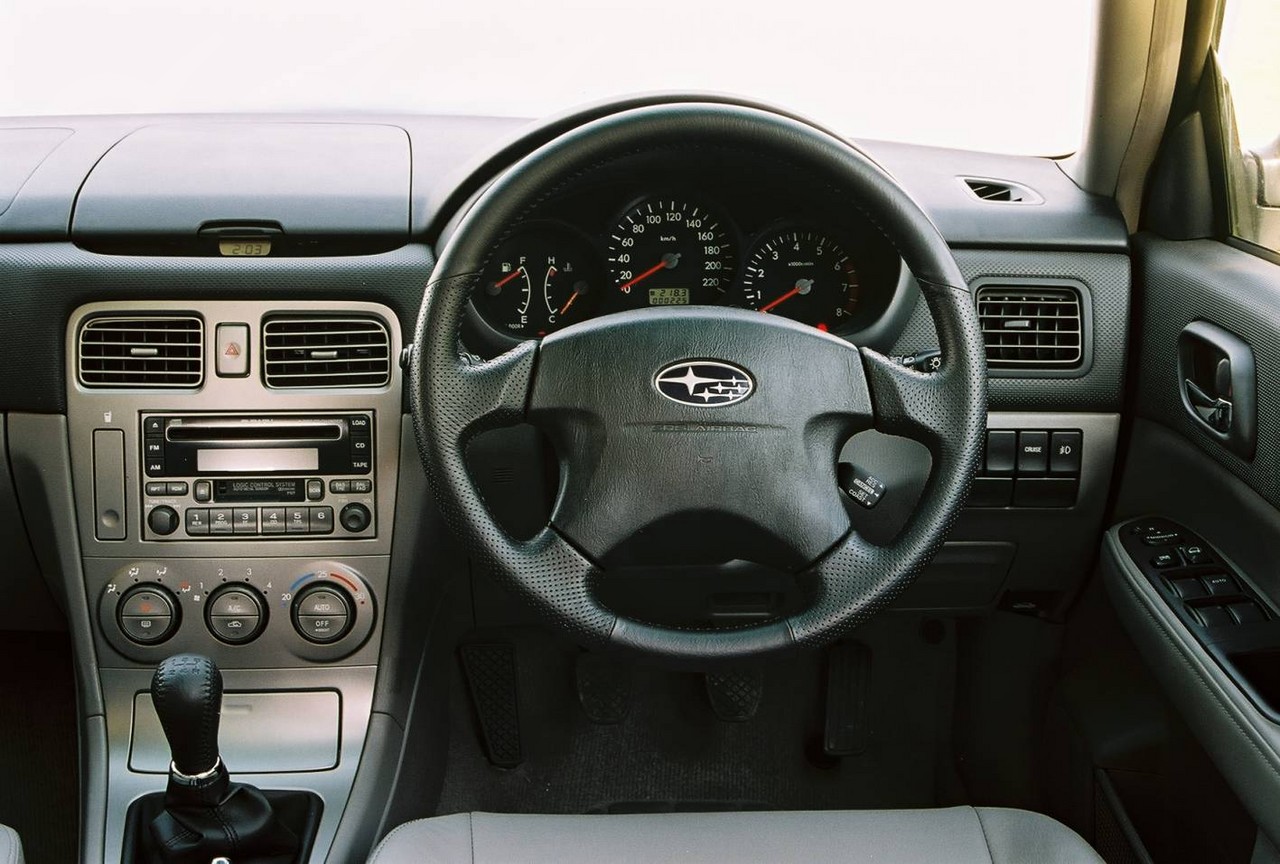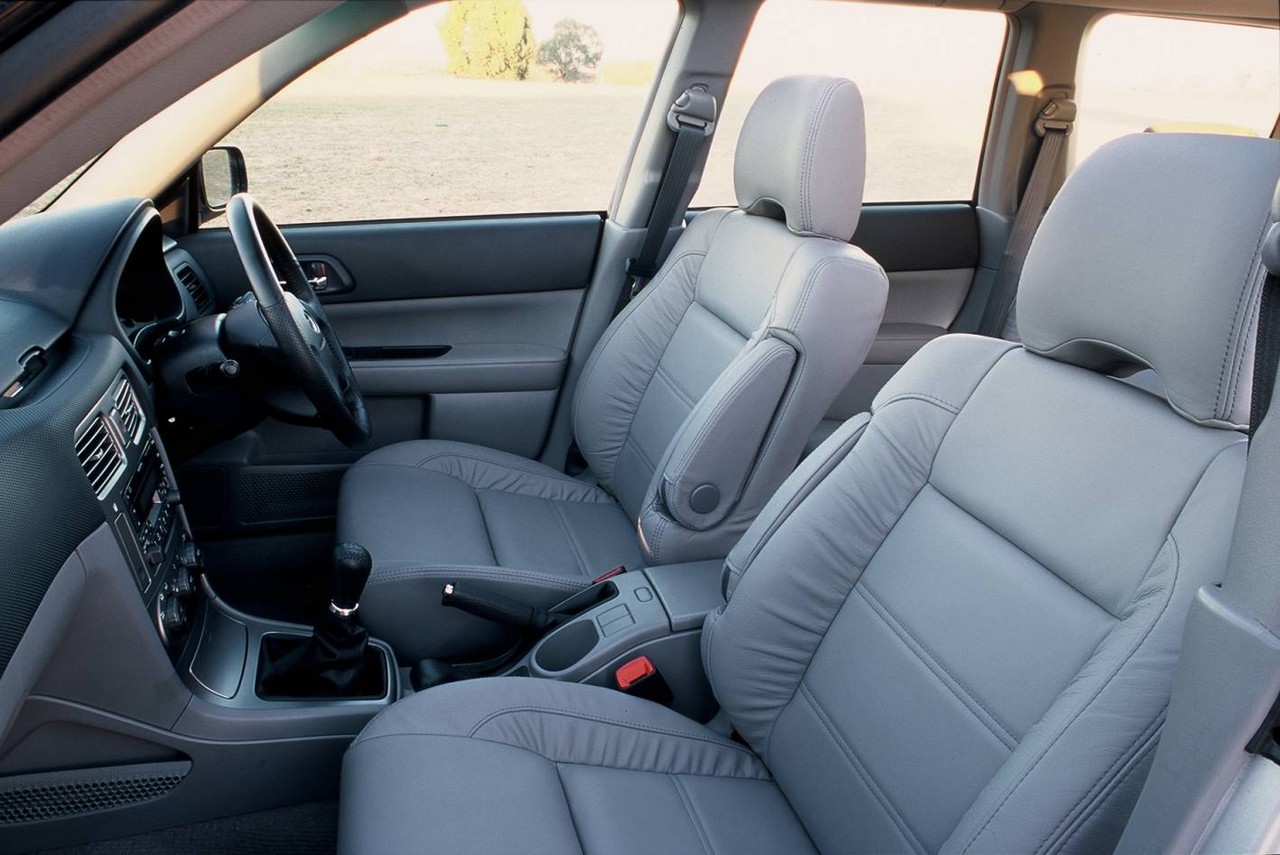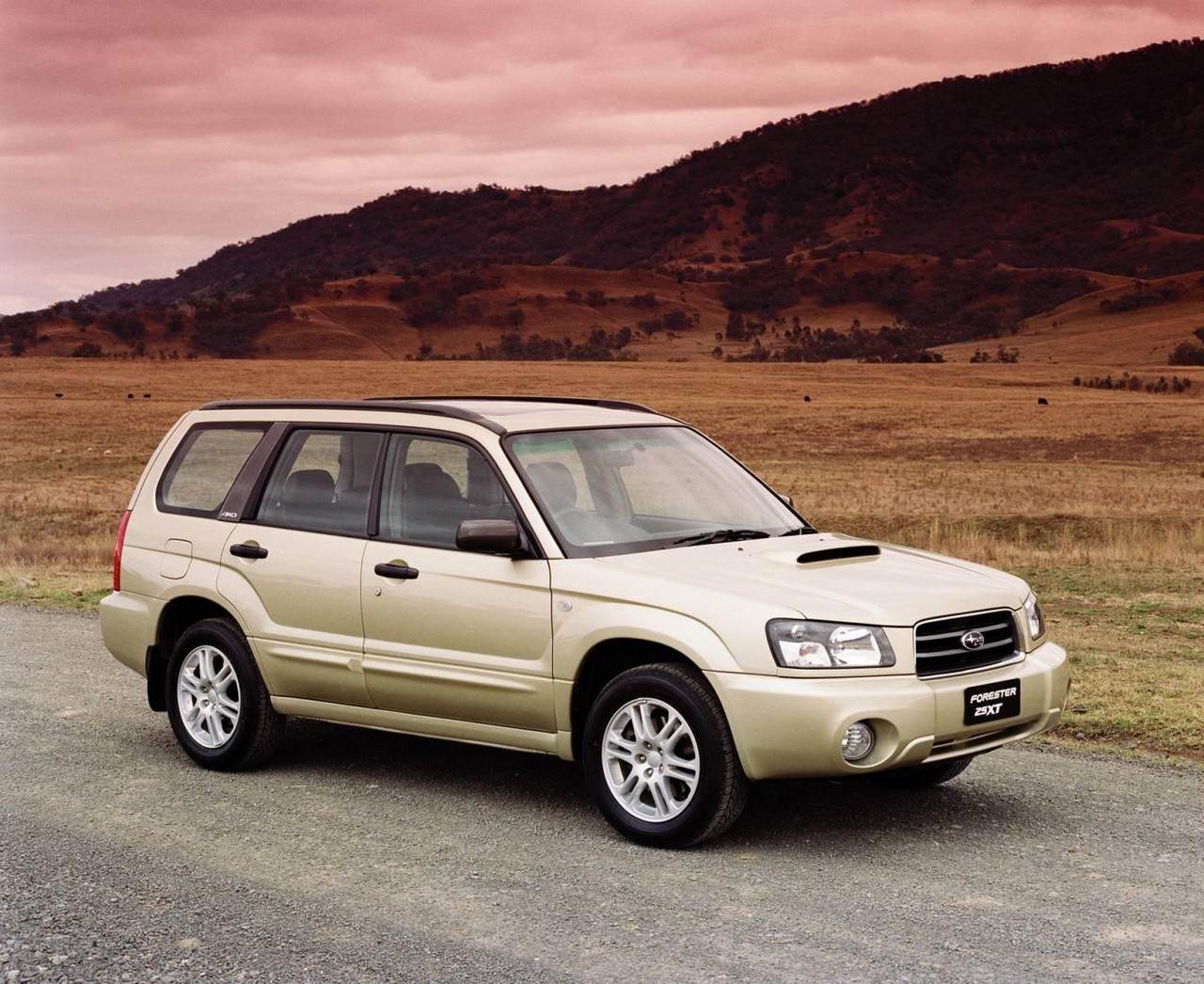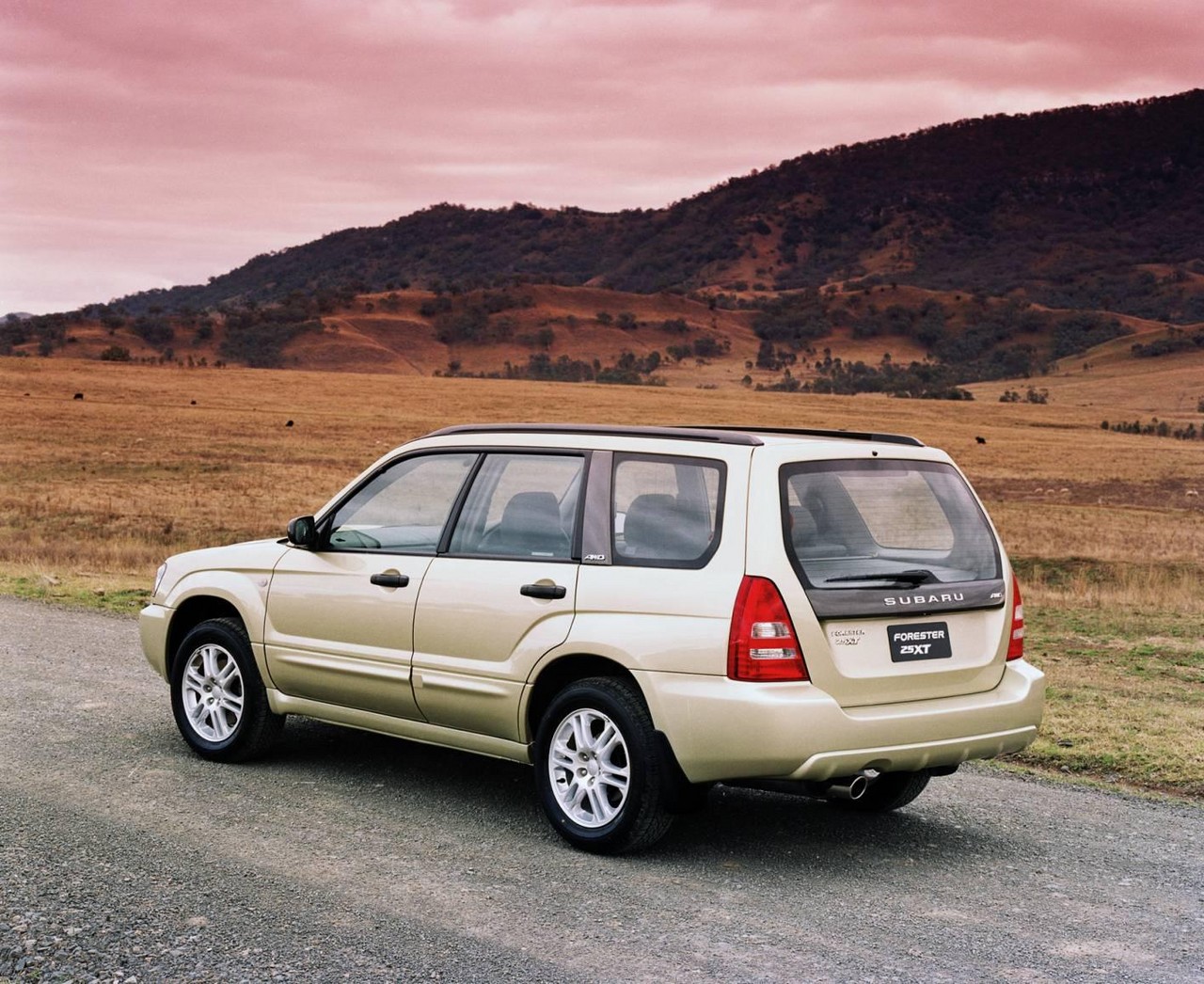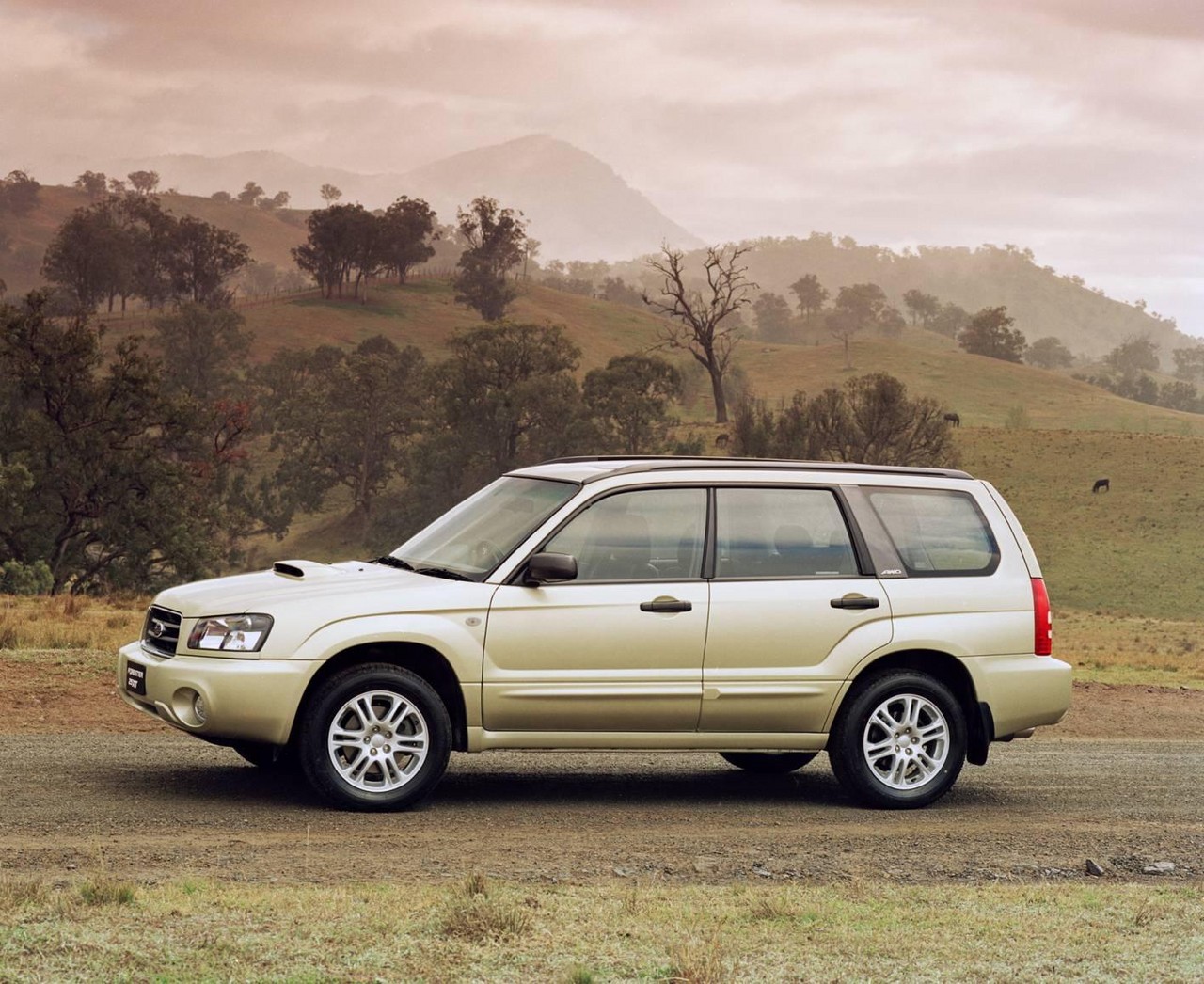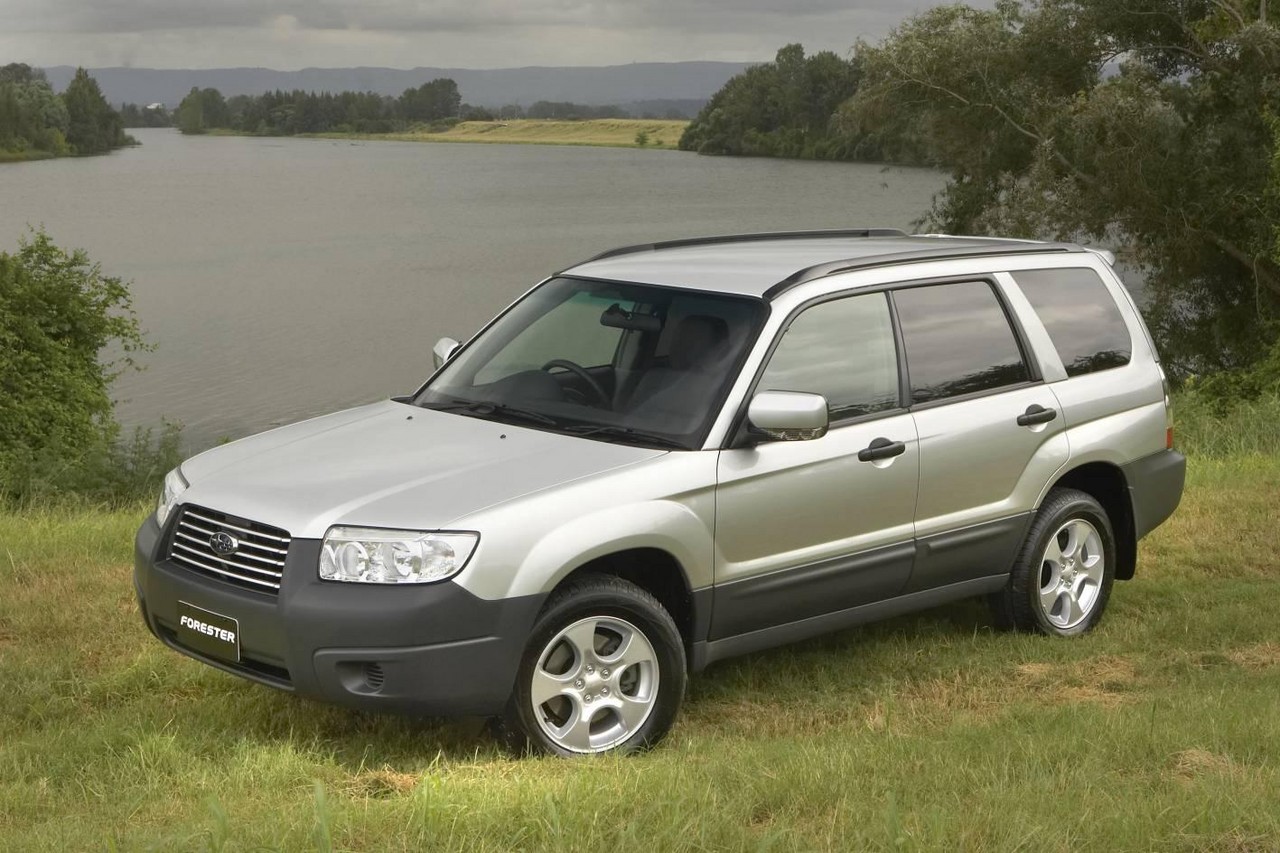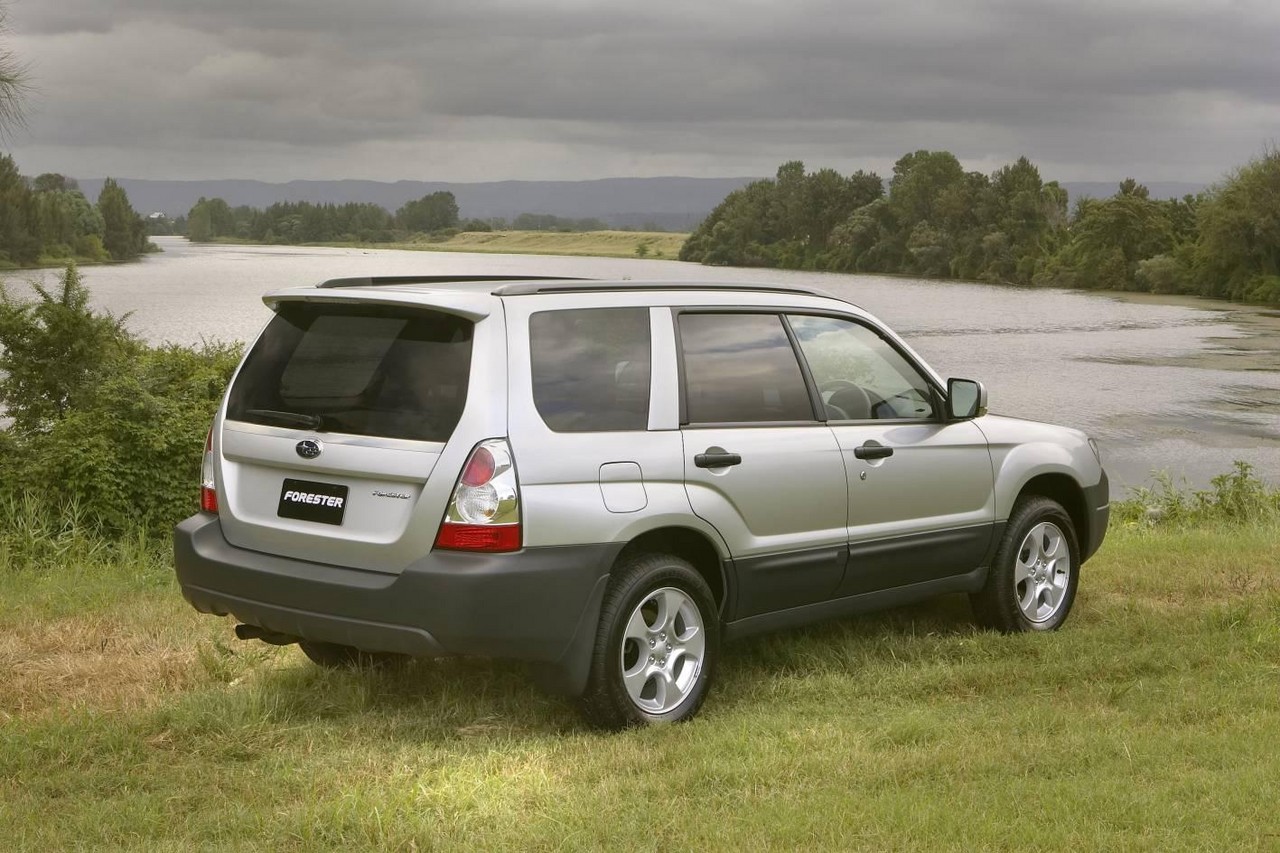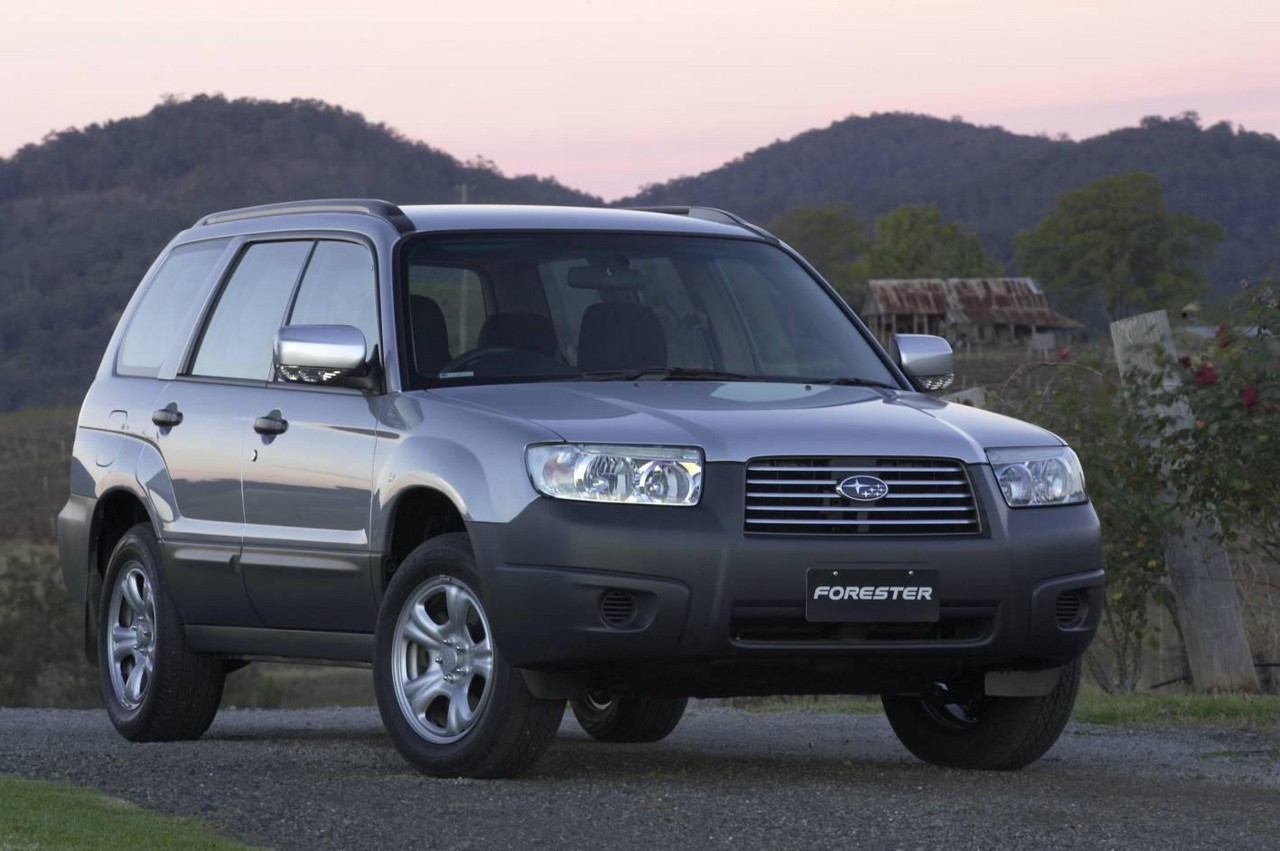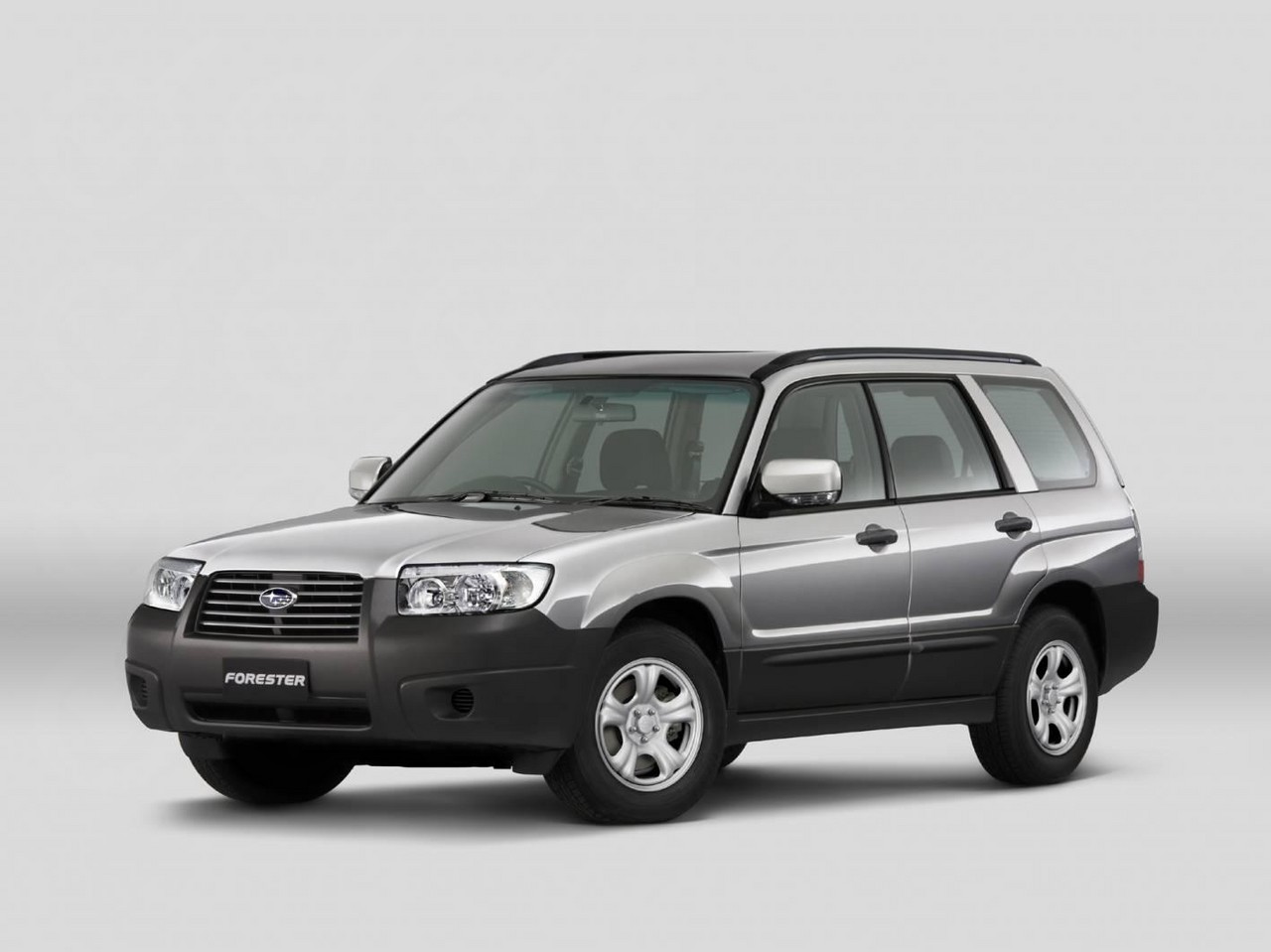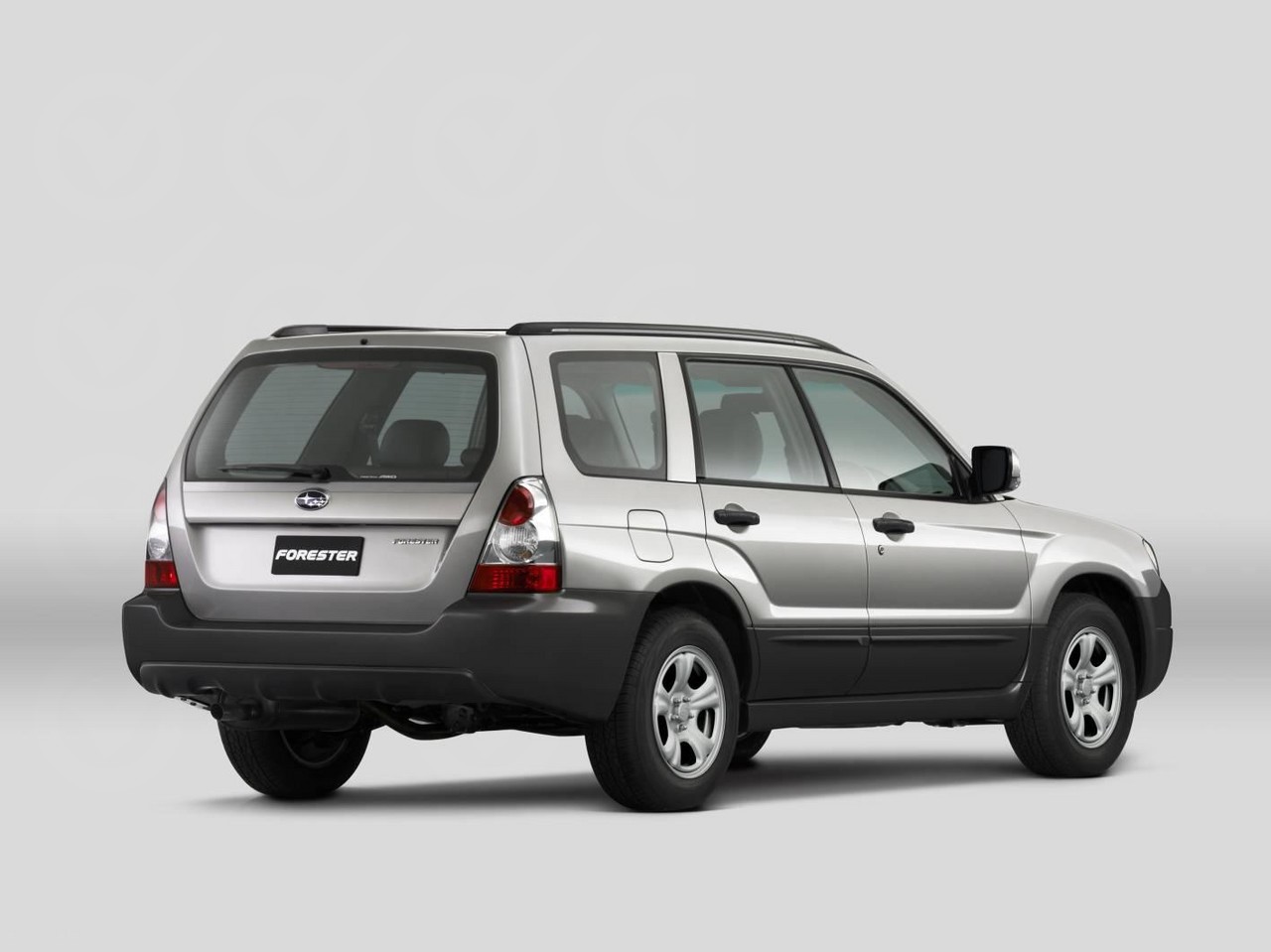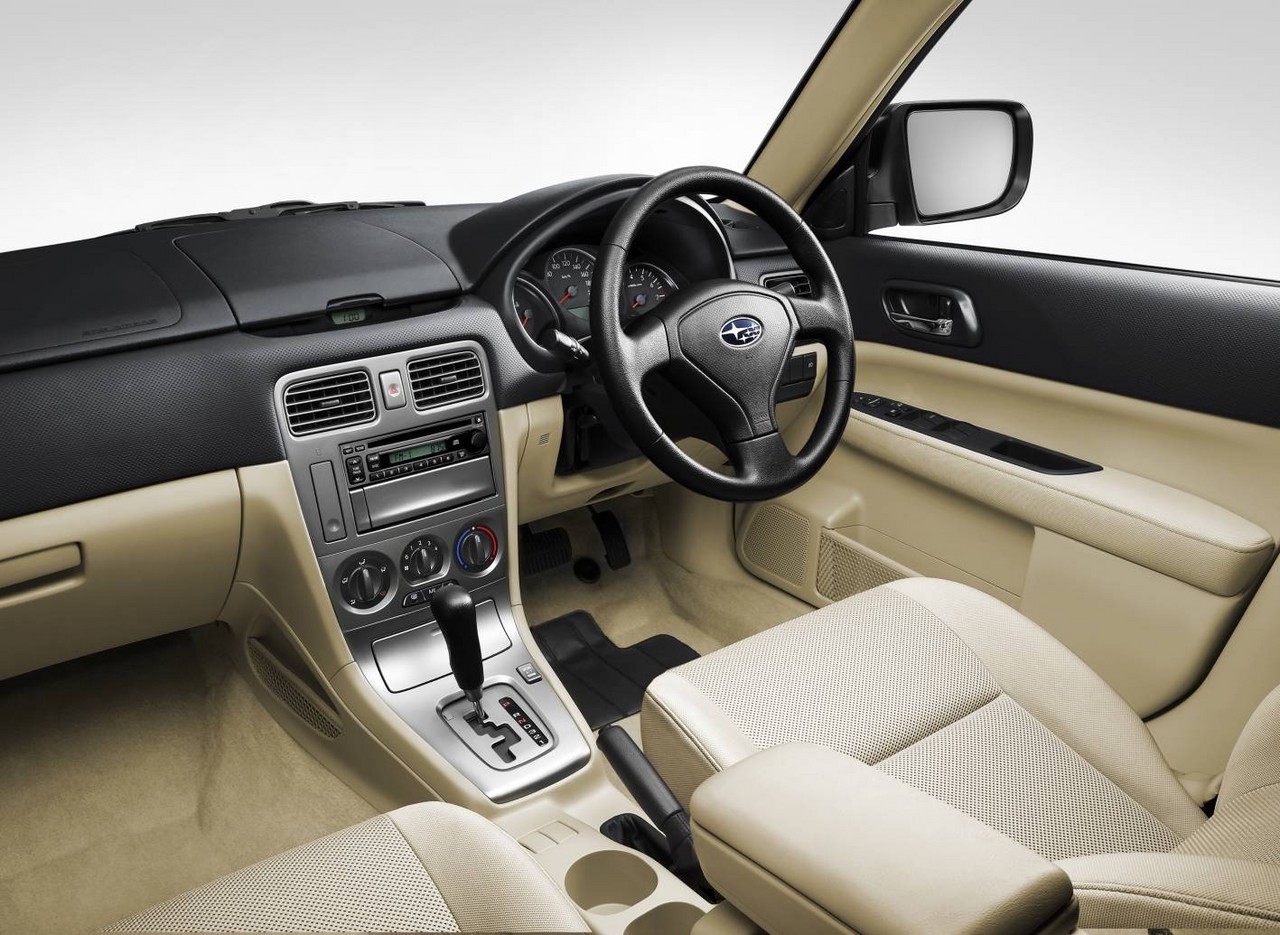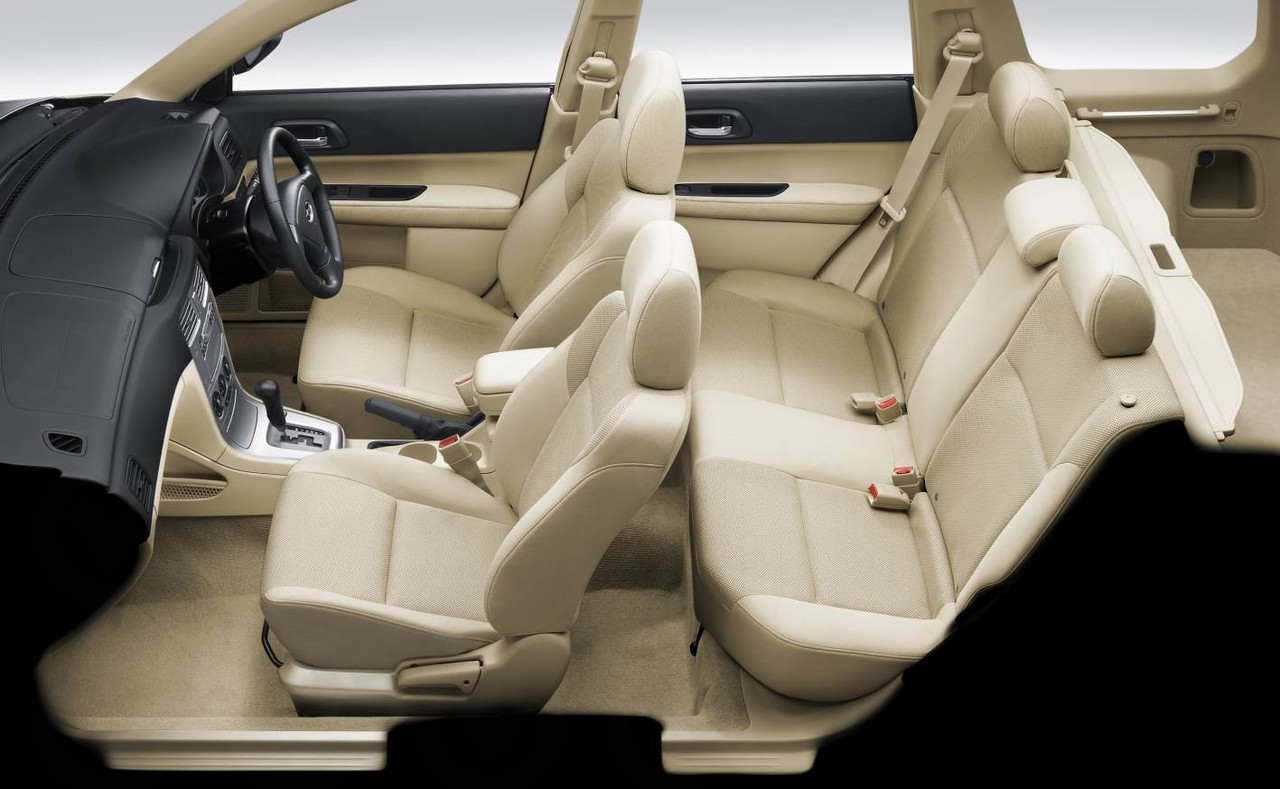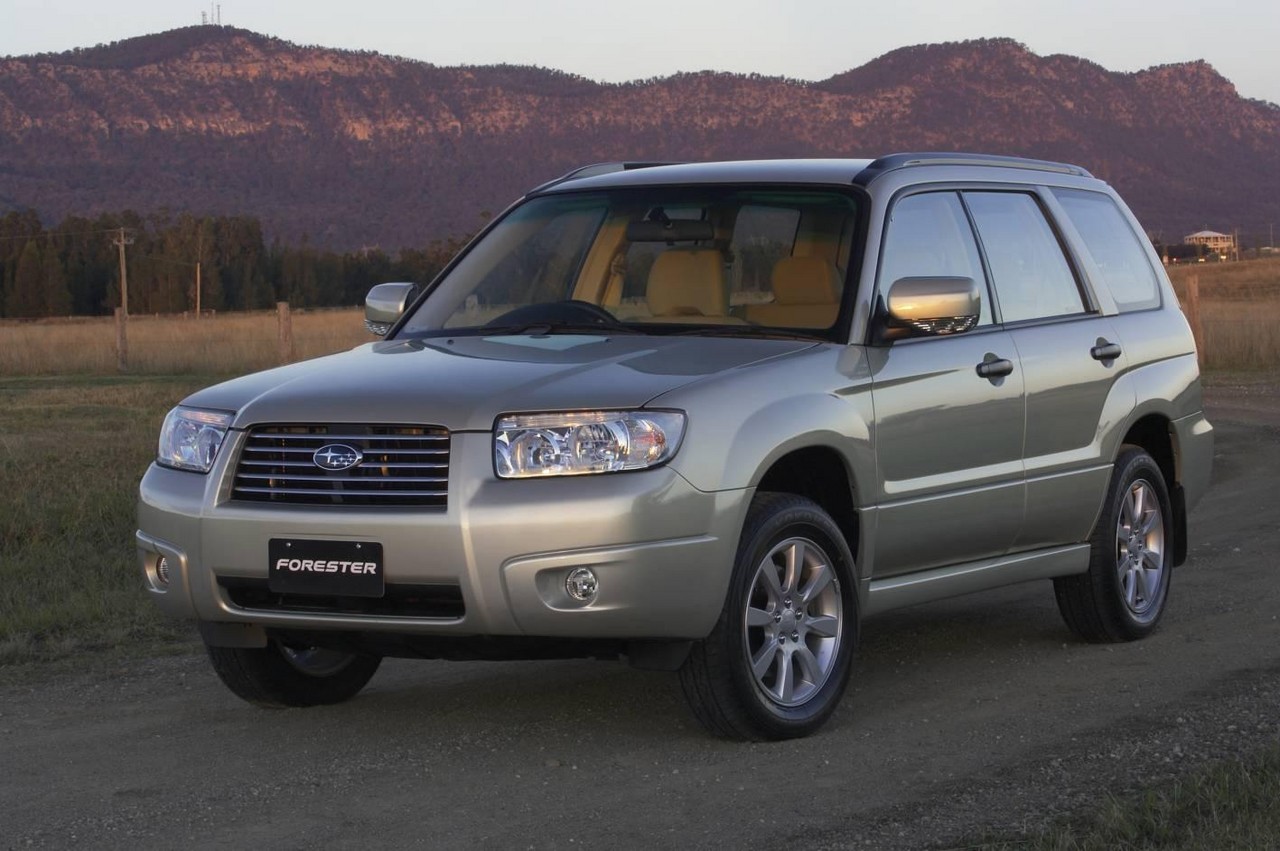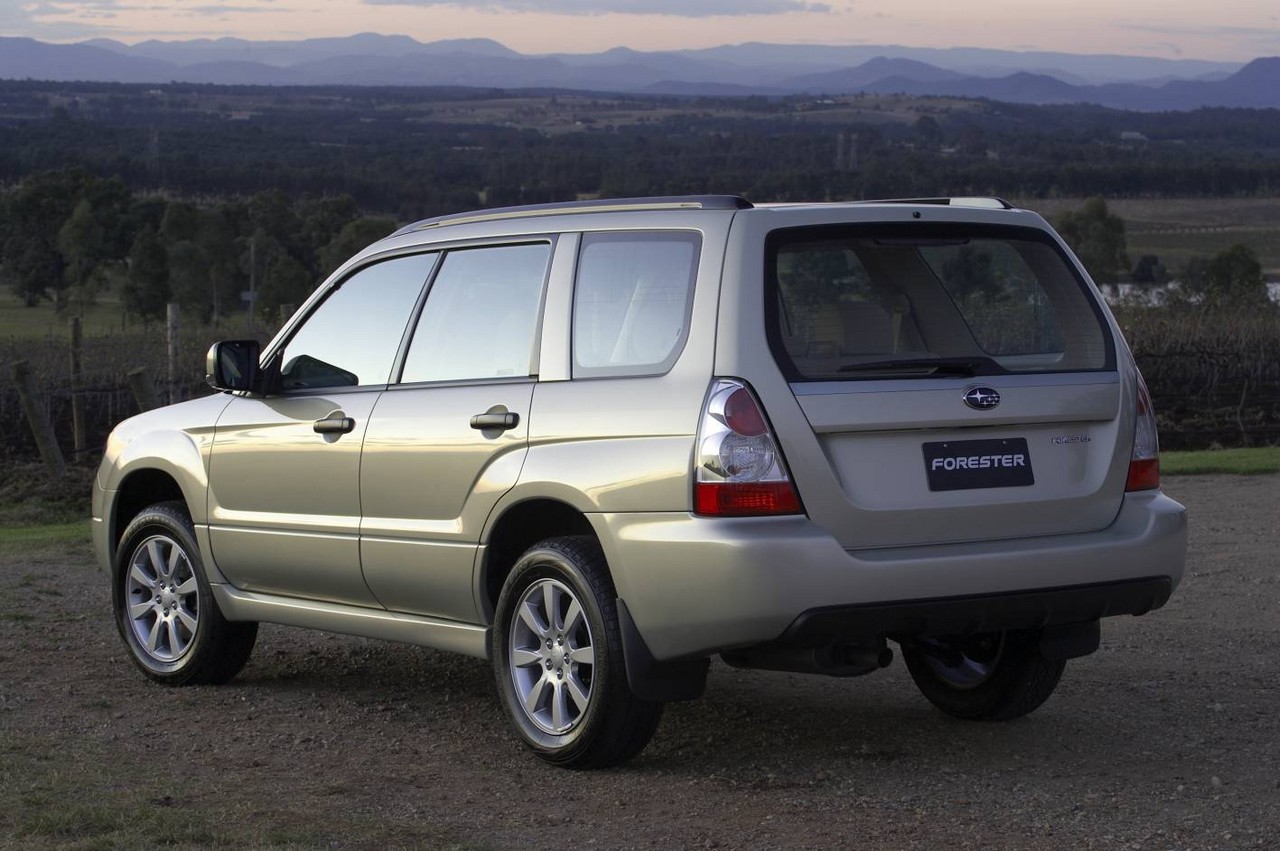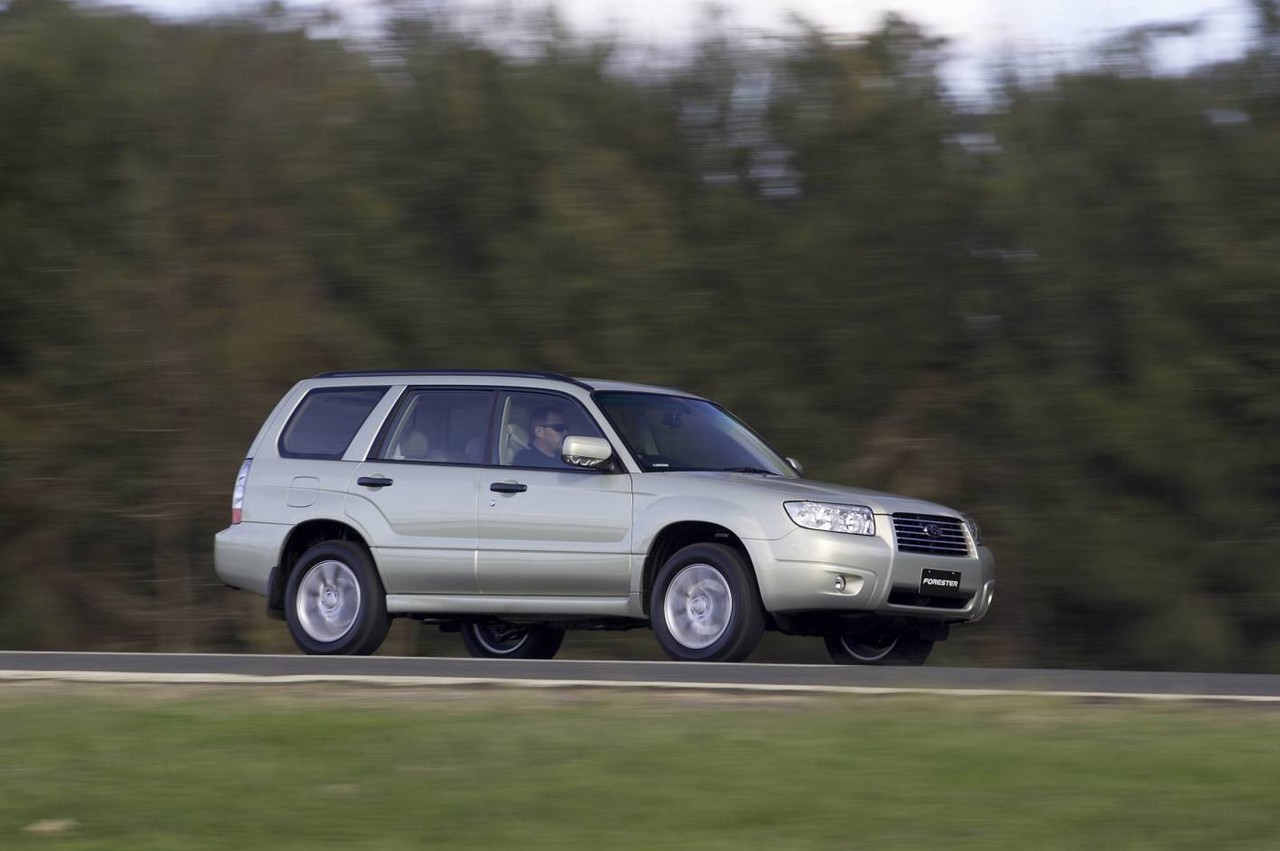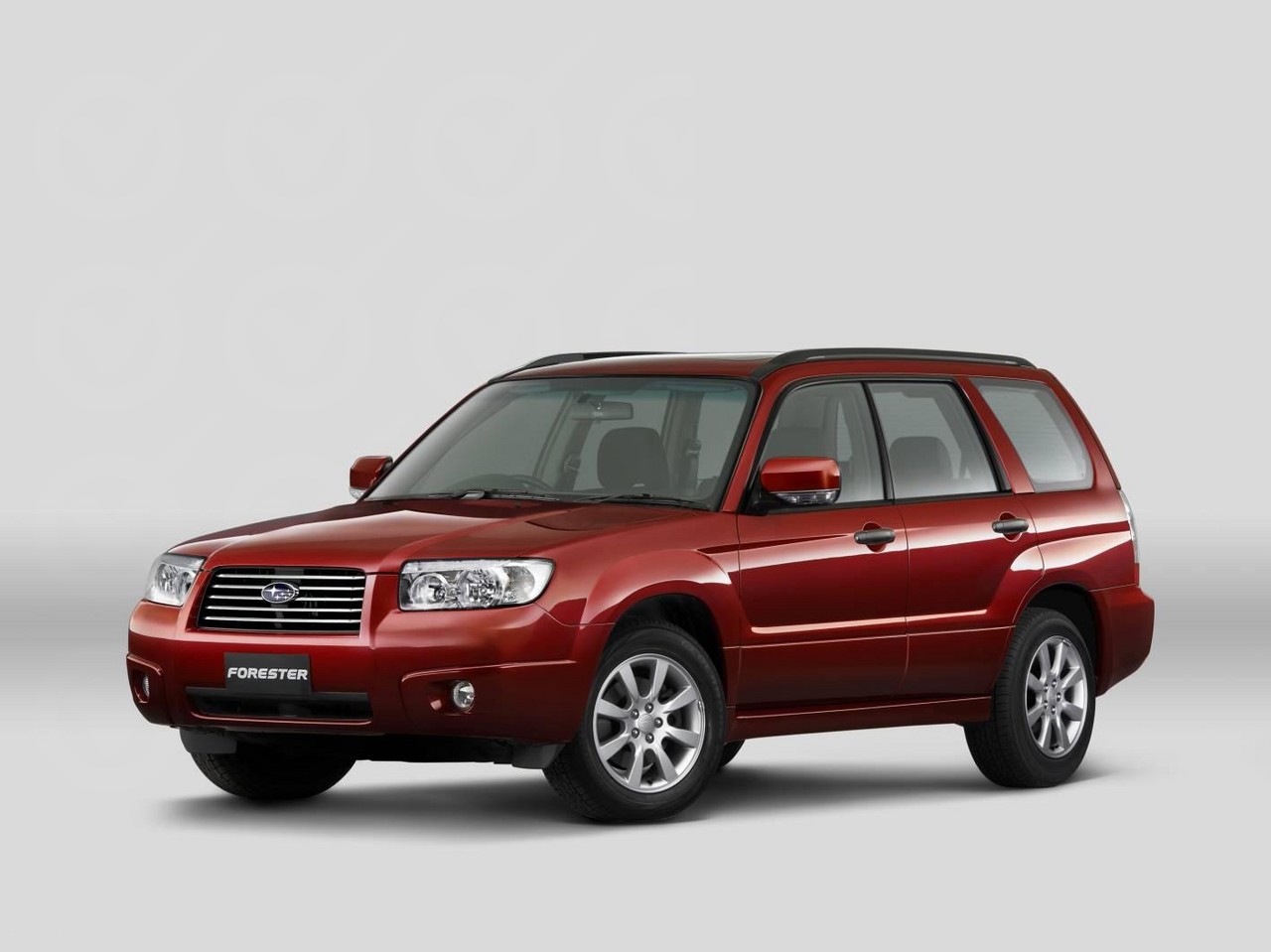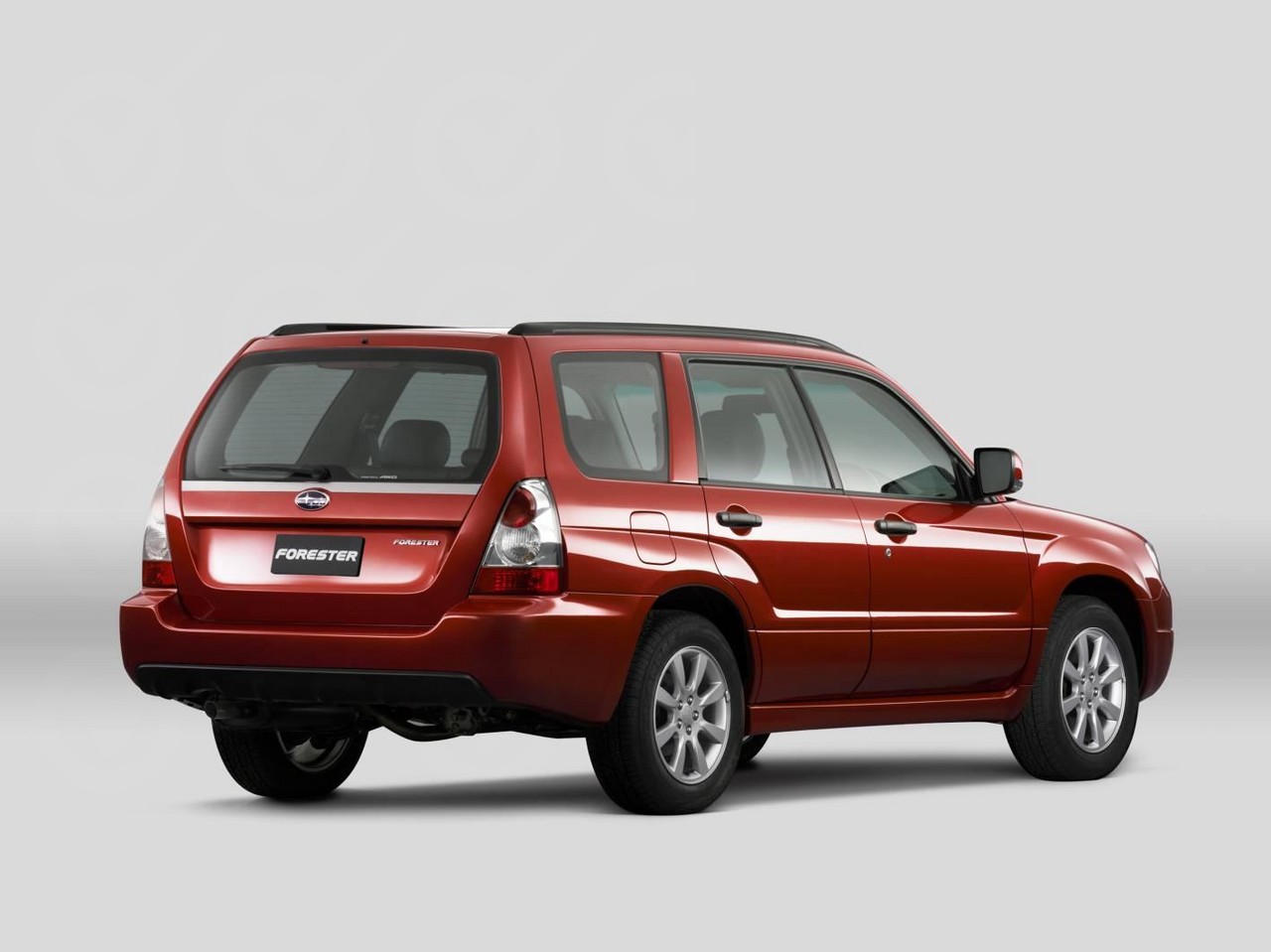
- Comfortable ride
- Safe, predictable handling
- Dual range manual transmissions provide off-road ability
- All-wheel drive traction (but three very different AWD systems)
- For 2.5-litre petrol engine, intrusive engine noise
- Standard all-terrain tyres lack on-road grip
- Slow gearshifts for automatic transmission
- Limited rear leg room
- 2.5-litre EJ25 F4 engine susceptible to head gasket failure
Review: Subaru SG.I Forester (2002-05)
Overview
Released in July 2002, the Subaru SG Series I (SG.I) Forester was a five-seat, all-wheel drive wagon. Manufactured in Ota, Japan, the Subaru SG Forester range initially consisted of the X and XS variants, powered by 2.5-litre horizontally-opposed (or flat) four-cylinder petrol engines. In August 2003, however, the turbocharged Forester XT was released.
Both engines were available with four-speed automatic and five-speed manual transmissions.
EJ251 and EJ255 engines
For the Forester X and XS, the naturally aspirated 2.5-litre EJ251 engine had an open-deck aluminium alloy block with cast iron liners, an aluminium alloy cylinder head, a single overhead camshaft per cylinder bank (belt-driven), four valves per cylinder actuated by shimless buckets, multipoint sequential fuel injection and a compression ratio of 10.1:1.
For the Forester XT, the turbocharged 2.5-litre EJ255 engine had a semi-closed die-cast aluminium block with cast iron liners, an aluminium cylinder head with cross-flow cooling, double overhead camshafts per cylinder bank (belt-driven), four valves per cylinder, variable intake valve timing (Subaru’s ‘Active Valve Control System’ or AVCS), Tumble Generator Valves (TGVs) and a compression ratio of 8.2:1. For the SG Forester XT, the EJ255 engine had a Mitsubishi TD04L turbocharger which provide maximum boost pressure of 600 mm Hg (11.6 psi).
Dimensions and body
Compared to the Subaru SF Forester , the SG Forester was 10 mm shorter (at 4450 mm) and 5 mm lower (1590 mm), though width (1735 mm), wheelbase length (2525 mm) and ground clearance (200 mm) were unchanged. The SG Forester had a stronger and lighter structure due to the introduction of an aluminium bonnet, a hydroformed front subframe and high tensile strength materials integrated into the B-pillars.
Suspension
The Subaru SG Forester had MacPherson strut front suspension and dual link rear suspension, while body roll was reduced through the use of larger front and rear stabiliser bars and internal shock absorber rebound springs.
| Variant | Editions | Years | Engine | Trans. | Peak power | Peak torque |
|---|---|---|---|---|---|---|
| X | [Unnamed] | 2002-05 | 2.5-litre EJ251 petrol F4 | 4sp auto, 5sp man | 112 kW at 5600 rpm | 223 Nm at 3600 rpm |
| Special Edition | 2004 | |||||
| Weekender | 2005 | |||||
| XS | [Unnamed] | 2002-05 | ||||
| Luxury | 2002-05 | |||||
| XT | [Unnamed] | 2003-05 | 2.5-litre EJ255 turbo petrol F4 | 4sp auto, 5sp man | 155 kW at 5600 rpm | 320 Nm at 3600 rpm |
| Luxury | 2003-05 |
AWD systems
The Subaru SG Forester was available with three all-wheel drive (AWD) systems:
- Models with manual transmissions were fitted with Subaru’s ‘Continuous’ AWD system which utilised a viscous-coupling locking centre differential. In normal conditions, the system provided a 50:50 front:rear torque distribution. If traction was lost, however, up to 80 per cent of the engine’s torque could be directed to the opposing axle. Manual models were also fitted with dual range transmissions and featured a ‘hill holder’ function.
- For Forester X and XS variants with automatic transmissions, an ‘Active Torque Split’ system was fitted which consisted of an electronically-controlled, hydraulic multi-plate transfer clutch (instead of the centre differential). In normal conditions, the system provided an 80:20 front:rear torque split but sensors – measuring wheel slippage, throttle position and braking – could anticipate a loss of front-wheel traction and transfer torque to the rear axle.
- For Forester XT variants with automatic transmissions, a ‘Variable Torque Split’ system was fitted – this system utilised an electronically-controlled, hydraulic multi-plate clutch which operated in conjunction with the centre planetary-type differential. In normal conditions, the system provided a 45:55 front:rear torque split, though sensors – monitoring wheel slippage, throttle position and braking – could determine the amount of clutch lock to apply.
Furthermore, all Foresters were fitted with a limited slip rear differential with viscous coupling, enabling rear axle torque to be directed to the wheel with most grip.
Safety equipment
Standard safety equipment for the Subaru SG.I Forester included dual front airbags, ABS, electronic brake force distribution, active front seat head restraints and front seatbelt pretensioners (with an anti-submarining driver’s seat lap pretensioner). Luxury editions were further equipped with front side airbags with head and shoulder protection. From August 2004, however, front side airbags were standard across the range.
ANCAP crash testing
In ANCAP crash testing , a 2002 Forester X – equipped with dual front airbags – received a four star adult occupant protection rating with a score of 28.78. In the offset crash test, there was a slight risk of serious chest and leg injury for both front occupants. In the side impact test, maximum points were awarded.
Models produced after February 2003 had improved knee protection and a driver’s seatbelt reminder. In ANCAP crash testing, a post-February 2003 Forester – equipped with dual front airbags and front side airbags – received a five star adult occupant protection rating with a score of 32.78.
Features: Forester X, XS, XT and Luxury
Standard features for the Subaru SG Forester X included 16-inch steel wheels, a four speaker sound system with CD player, air conditioning, cruise control, 60/40 split and folding rear seats, remote central locking, power windows and mirrors, a height adjustable steering wheel, two 12 volt power outlets, map lights, roof rails and an immobiliser.
The Forester XS and XT were further equipped with 16-inch alloy wheels, a six-stack CD player, climate control air conditioning, front fog lights and self-levelling rear suspension. Beyond this, the Luxury editions added leather seats, leather trim and a power sunroof.
Forester XT and August 2003 update
In August 2003, the turbocharged XT variant was released. Although similarly equipped to the XS, the XT was equipped with drive-by-wire throttle control and automatic models featured direct solenoid shift control (Subaru’s ‘Direct AT’) for smoother and more responsive gear shifts. The SG.I Forester range also underwent a minor cosmetic update with black headlight surrounds and a chrome grille; the front doors were also strengthened and there were new brake pads and calipers.
August 2004: Forester update
The SG.I Forester underwent another minor update in August 2004. In addition to front side airbags being fitted across the range, these updated models introduced three-spoke steering wheels and upgraded audio systems; automatic models also had a ‘shift lock’ which required that the key be in the ignition ‘on’ position and the brake depressed before the gearshift could be moved from park. Furthermore, the XS variant was fitted with eight-spoke alloy wheels, a 60 watt 2DIN head unit with seven speakers and simplified air conditioning controls. The XT also added a seventh speaker and featured a Momo steering wheel; towing capacity increased for manual XT variants from 1400 kg to 1800 kg.
2004 Forester X Special Edition
In May 2004, a limited-run Forester X Special Edition was released. Compared to the standard Forester X, the Special Edition added 16-inch alloy wheels (including a steel spare), a leather-wrapped steering wheel and gearshift, floor mats, moulded cargo mat and roof racks.
2005 Forester Weekender
In January 2005, a limited-run Weekender edition of the X variant was released. Compared to the standard Forester X, the Weekender edition added 16-inch alloy wheels (including a steel spare), leather seats, tinted rear windows, a moulded cargo mat and rear spoiler.
Review: Subaru SG.II Forester (2005-08)
Overview
Released in August 2005, the SG Series II (SG.II) Forester introduced more powerful EJ253 and EJ255 engines, ‘drive by wire’ electronic throttle control and revised suspension settings for improved handling. The SG.II Forester could be identified by its twin head and tail lights, revised grille and bumpers, front quarter guard and indicators incorporated into the larger wing mirrors. Inside, the SG.II Forester had a new multi-function centre console which also served as a sliding front armrest with two cup holders and a sliding tray for rear passengers. Furthermore, there was a choice of black or beige interior trim and the rear seats were extended for greater thigh support.
EJ253 and EJ255 engines
Compared to the EJ252 engine which it replaced, changes for the EJ253 included:
- Reinforced casting around the engine’s main bearing journal;
- Alterations to cylinder liner shape; and,
- The introduction of Tumble Generator Valves (TGVs) to reduce start-up emissions.
For the Forester XT’s EJ255 engine , the compression ratio was increased to 8.4:1 (previously 8.2:1).
Transmissions
For models with the EJ253 engine , the SG.II Forester was fitted with Subaru’s ‘Direct AT’ automatic transmissions which used a high-frequency linear solenoid (rather than hydraulic valves and accumulators) to regulate the pressure applied to each of the clutches and brakes in the transmission, thereby providing improved gearshift quality.
The Forester XT was fitted with a ‘Sportshift’ transmission which had a sequential shift mode and could up- or down-shift gears within the specified range (i.e. if set to “3”, it would use the first, second and third gears). The Sportshift transmission also considered cornering, braking and acceleration when determining gear selection.
| Variant | Edition | Years | Engine | Trans. | Peak power | Peak torque |
|---|---|---|---|---|---|---|
| X | [Unnamed] | 2005-08 | 2.5-litre EJ253 petrol F4 | 4sp auto, 5sp man. | 121 kW at 5600 rpm | 226 Nm at 4400 rpm |
| Luxury | 2006-07 | |||||
| Weekender | 2006 | |||||
| Sports | 2006 | |||||
| Columbia | 2007 | |||||
| XS | [Unnamed] | 2005-08 | ||||
| Luxury | 2005-08 | |||||
| XT | [Unnamed] | 2005-08 | 2.5-litre EJ255 turbo petrol F4 | 4sp auto, 5sp man. | 169 kW at 5600 rpm | 320 Nm at 3600 rpm |
| Luxury | 2005-08 |
Features: Forester X, XS and XT
Standard features for the Subaru SG.II Forester X were extended to include water-repellent cloth trim. The Forester XS gained front fog lights, while the Forester XT was further equipped with 17-inch alloy wheels and high intensity discharge headlights with washers.
August 2006 update and Forester Sports edition
In August 2006, the Forester range underwent a minor update, with the XS and XT variants receiving tinted UV glass for the rear passenger, quarter and back windows, a rear spoiler and upgraded radios (which could scan for stronger frequencies); furthermore, satellite navigation became optional for the Luxury editions. A limited-run Forester X Sports edition was also released; compared to the standard Forester X, the Sports edition was distinguished by its 16-inch alloy wheels, front fog lights, rear cargo cover, floor mats, roof racks and rear spoiler.
2006 Forester X Luxury
In January 2006, a limited-run Forester X Luxury edition was introduced; it featured leather seats, a sunroof and rear tinted windows.
2006 Forester Weekender
In March 2006, a limited-run Weekender edition of the X variant was released. Compared to the standard Forester X, the Forester Weekender edition added 16-inch alloy wheels, leather seats, a leather-wrapped steering wheel, tinted rear windows, moulded cargo mat and rear spoiler.
2007 Forester Columbia
In August 2007, a limited-run Forester X Columbia edition was released; it was distinguished by its leather seats, power sunroof, rear tinted windows and rear spoiler.
Related links
